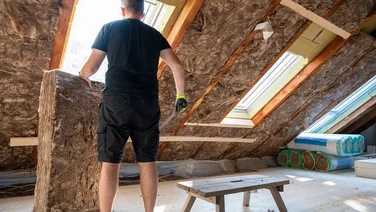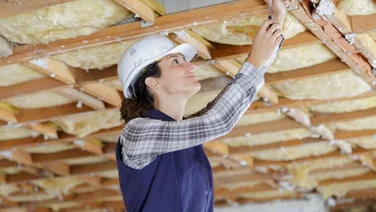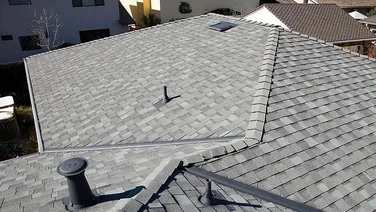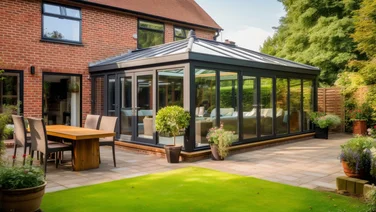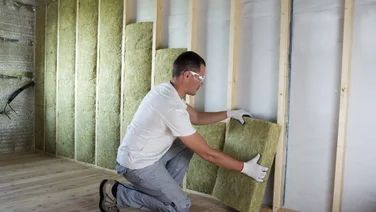- Loft insulation between rafters can save you up to £270 per year
- The impact depends on your loft type, the insulation material and your method of installation
- Loft insulation between rafters can increase your home’s value

Loft insulation between rafters is one of the most-effective ways to stop your home losing heat, which can help reduce energy bills long-term.
The process involves putting insulation on the underside of your roof, which ultimately helps regulate the temperature of your home, and this means you can save as much as £270 a year. It can also help reduce your carbon footprint by 0.7 tonnes per year.
Insulating your loft is a good idea overall, as it can help keep your home warmer during the winter – especially as temperatures continue to drop year-on-year.
It also makes it easier to use your loft area as a living space or work from home office, as this process is insulated alongside the rest of your home.
But like most energy-efficient measures, the impact of loft insulation between the rafters depends on your loft type, the insulation material and your method of installation.
In this guide, we’ll dive into the full process in more detail, whether you can install it yourself, and the benefits of insulating the loft between rafters.
However, if you’ve already done the research and are ready for the next step, fill out our form for a free quote from our trusted suppliers.
Can I put loft insulation between the rafters myself?
Technically, yes, but it is not advisable, and you should definitely hire a professional installer.
Not only can things go wrong, you can hurt yourself and if the insulation is installed incorrectly, you’ll likely need a professional to fix it. This will ultimately cost you more, too, as the work you’ve done will need to redone.
If you’re unsure where to begin with installers, we can help. Simply fill in our form, and we’ll put you in touch with our trusted suppliers.
How much does loft insulation between rafters cost?
The cost of roof insulation depends on the type you choose to install, as well as the type of house you line in.
For example, a terraced house can expect to pay the following for loft insulation:
- Blanket insulation – £125-£160
- Loose fill insulation – £180-£225
- Sheet insulation – £250-£310
- Blown fibre insulation – £1,375-£1,720
On average, labour costs will cost around £150-£400 per day.
You can check out a full rundown of insulation costs in our guide: Loft insulation costs 2024.

What are the benefits of insulating the loft between rafters?
As mentioned already, your energy bills will likely reduce, and continue to do so as you increase the energy efficiency of your home.
This is because it retains the internal temperature, meaning your heating system won’t need to constantly overwork to top up lost heat. This leads to annual savings on energy bills of up to £380 in a detached UK home.
Loft insulation between rafters can help prevent damp and mould, too, as it helps close up any draughts.
Possibly the biggest benefit is loft insulation between rafters can increase your home’s value. This is because it will help improve your Energy Performance Certificate (EPC) rating.
What are the building regulations for insulation between rafters?
The main things to be aware of when installing between rafters are:
- Insulation thickness – The UK building regulations for warm loft insulation ask to achieve a U-value of around 0.20W/m². This technically means your loft space would be better insulated than even your home walls. This would require a minimum of 270mm of mineral or sheep wool insulation. For the best results, 300mm of insulation is best.
- Air gap – Ventilation is necessary so that the insulation doesn’t collect moisture, leading to mould, rot and structural damage. An air gap of a minimum of 25mm, or ideally 50mm, is recommended between the insulation and the underside of your roof tiles.
- Permissions – Generally speaking, permissions are not required from the local authority when carrying out a loft insulation project, however working with a professional installer can help make sure that if need be, a notice can be made on your behalf.
What is the best loft insulation for rafters?
When choosing loft insulation between rafters, you should consider the cost, sustainability and thermal performance.
While your installer will be able to advise for your specific needs, mineral wool insulation is one of the more popular materials.
This is because it’s more affordable than other available options, it’s also easy to install and is effective at helping to retain heat.
From a sustainability perspective, however, treated sheep’s wool is considered more effective. It is more expensive, though.
Other materials to consider are:
- Single or multi-layer foil – An affordable and easy-to-install option that can reflect more than 97% of radiant heat.
- PIR board – A reflective option with low thermal conductivity that’s specified for shallow rafters. It does need to be cut to the size of the rafter, though.
- Phenolic board – This offers the highest thermal performance, but also requires the biggest investment.
Summary
- Loft insulation between rafters is one of the most-effective ways to reduce your home’s heat loss, which can help reduce energy bills long-term.
- The process involves putting insulation on the underside of your roof, which ultimately helps regulate the temperature of your home
- The cost of roof insulation depends on the type you choose to install, as well as the type of house you line in
- Use an installer, as they will make sure the material is correctly installed and control internal moisture sources
- When choosing loft insulation between rafters, you should consider the cost, sustainability and thermal performance


